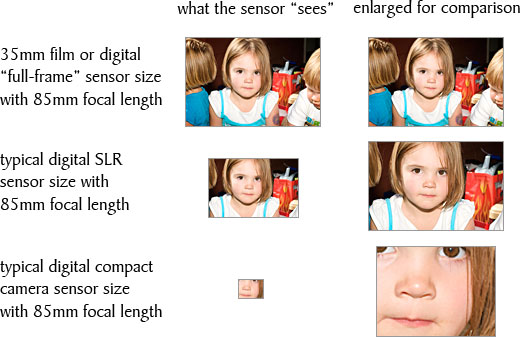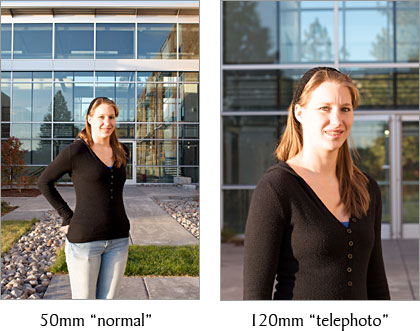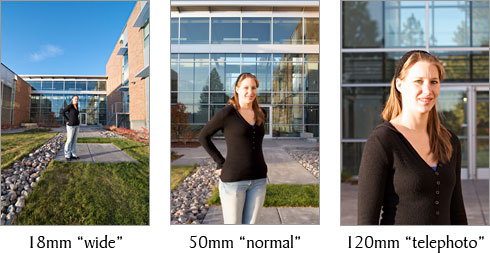A lens which creates an image with a field of view similar to what a human being "sees" is referred to as a "normal" lens. On a 35mm camera a lens with a focal length of about 40-50mm is considered "normal". Lenses with shorter focal lengths (less than 40-50mm) have a wider field of view and thus are considered "wide" lenses. Longer focal lengths (more than 50mm) have a narrower field of view and are referred to as "telephoto" lenses (also called "tele" lenses; pronounced "telly"); think "telescope" for long and narrow.

There is one confusing aspect regarding focal lengths; they are relative to the size of the film or sensor receiving the image. The lens and sensor are sized to work together to produce a particular image, just as the ingredients in a recipe for cookies work together to produce a particular cookie. If the amount of salt is increased in the recipe but the other ingredients remain the same, the cookies will be different; they will be too salty. The cookies can be made in a smaller batch but the ingredients will all have to be sized down equally to create the same cookies as in a larger batch.
In a camera if the sensor or film changes in size, the rest of the optical system must be enlarged or shrunk to produce the same image result. This means 40-50mm may be "normal" for a 35mm frame of film, but it is not necessarily so for other film sizes and camera types. Some cameras use larger or smaller film. Some high end digital cameras are "full frame" with a sensor equal to the size of a 35mm frame of film, on which 40-50mm is still "normal". However many professional digital cameras have slightly smaller sensors on which 30-35mm is "normal" and 50mm is a bit long. On a camera using a larger film size such as a 4x5 camera, 50mm would be wide.

The small consumer point-and-shoot digital cameras tend to have very small sensors with a similarly small focal range like 5.8mm-17.4mm. This sounds extremely wide but is in fact scaled appropriately to the sensor size and generally produces images similar to 35mm-105mm on a 35mm camera. Because 35mm cameras have been the most popular cameras for decades, focal ranges are usually thought of in relation to 35mm film. Most camera instruction books will list the "35mm equivalent" focal length for easier comparison.
While the photos on this site have all been taken with non full-frame cameras, these articles list the 35mm equivalent focal lengths. At some point in the future the individual photos available on this site will be udated to list the 35mm equivalent focal length as well.
The field of view isn't the only part of a wide or telephoto lens which isn't "normal". These lenses produce a different perspective than what human beings see. The most obvious example is a fisheye lens, which has a very wide and distorted field of view as though it is stretched around a ball. The images it produces are very abnormal to our view. However, other wide and telephoto lenses differ from human perspective as well.
Telephoto lenses create images which appear to be closer to the subject than they really are, as though the scene were magnified. Often used for portraits, sports and wildlife, these lenses also "compress" or "shorten" the perceived depth between objects in a photo making it seem as though the objects themselves are closer to one another than they are. Because this sense of depth is lessened, telephoto images may have a "flat" appearance and the geometry or "lines" of objects in the photo are more uniform with one another.

Wide lenses create images which appear further from the subject than they really are, "seeing more" as though the photographer were standing further away. Often used for landscapes or group portraits, these lenses usually increase the sense of depth between objects in a photo and often exaggerate the geometry or "lines" of the objects in the photo leading to distorted proportions and exaggerated perspective.

When photographed from the same point, each type of lens takes a noticeably different composition:

However the difference between how each type of lens "sees" differently from a human perspective can be more easily shown if the shooting distance is changed with each lens to produce a similarly sized main subject in the photo. While the subject remains in the same place in each shot notice how the sense of depth and perspective is seen differently by each lens:

Therefore wide, normal and telephoto lenses are not merely different magnifications; each can be used for a different perception of the same general composition.

